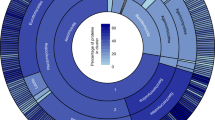Abstract
The incongruence between the gene trees and species remains a challenge in molecular phylogenetics. In this work, we propose a novel microarray approach to resolve this problem based on our previously proposed phylogenomic mining method. In our microarray approach, we first selected 28 genes from a set of statistically significant housekeeping genes from the S. cerevisiae cell cycle time series microarray data. Then we employed the BLAST and synteny criteria to identify homologs and orthologys of the selected genes among the genomes of other species. Finally, we applied the phylogenomic mining method for the aligned genes to infer the species phylogeny. The phylogenetic mining method used the self-organizing map mining, hierarchical clustering and entropy measure to concatenate the phylogenomically informative genes to infer species phylogenies. Compared with the original gene concatenation approach, our method not only overcome the ad-hoc mechanism and prohibitive phylogenetic computing problem of the species inference for the large number of taxa but also first integrated the microarray techniques in the species phylogeny inference.
Preview
Unable to display preview. Download preview PDF.
Similar content being viewed by others
References
Nei, M., Kumar, S.: Molecular Evolution and Phylogenetics, 2nd edn. Oxford University Press, Oxford (2000)
Page, R., Charleston, M.: From Gene to Organismal Phylogeny: Reconciled Trees and the GeneTree/Species Tree Problem. Molecular Phylogenetics and Evolution 7, 231–240 (1997)
Ma, B., Li, M., Zhang, L.: From Gene Trees to Species Trees. SIAM Journal on Computing 30, 729–752 (2000)
Huelsenbeck, J.P.: Performance of Phylogenetic Methods in Simulation. Systematic Biology 44, 17–48 (1995)
Delsuc, F., Brinkmann, H., Philippe, H.: Phylogenomics and the Reconstruction of the Tree of Life. Nature Review Genetics 6, 361–375 (2005)
Moret, B., Tang, J., Warnow., T.: Reconstructing Phylogenies from Gene-Content and Gene-order Data. In: Mathematics of Evolution and Phylogeny, pp. 321–352. Oxford Univ. Press, Oxford (2005)
Rokas, A., Williams, B., King, N., Carroll, S.: Genome-scale Approaches to Resolving Incongruence in Molecular Phylogenies. Nature 425, 798–804 (2003)
Huelsenbeck, J., Ronquist, F.: MRBAYES: Bayesian Inference of Phylogenetic Trees. Bioinformatics 17, 754–755 (2001)
Felsentein, J.: Inferring Phylogenies. Sinauer Associates, Inc. (2004)
Shimodaira, H., Hasegawa, M.: Multiple Comparisons of Log-likelihoods with Applications to Phylogenetic Inference. Molecular Biology and Evolution 16, 1114–1116 (1999)
Han, X.: Resolve the Gene Tree and Species Tree Problem by Phylogenetic Mining. In: Proceedings of 4th Asia-Pacific Bioinformatics Conference (APBC), pp. 287–296. Imperial College Press, London (2006)
Han, X.: A Machine Learning Approach to Resolving Incongruence in Molecular Phylogenies and Visualization Analysis. In: Proceedings of the 2005 IEEE Symposium on Computational Intelligence in Bioinformatics and Computational Biology, pp. 346–353 (2005)
Haykin, S.: Neural Networks: A Comprehensive Foundation, 2nd edn. Prentice-Hall, Englewood Cliffs (1999)
Kohonen, T.: Self-Organizing Maps, 3rd edn. Springer, Berlin (2001)
Nikkila, J., Toronen, P., Kaski, S., Venna, J., Castren, E., Wong, G.: Analysis and Visualization of Gene Expression Data using Self-organizing Maps. Neural Networks, 15. Special issue on New Developments on Self-Organizing Maps, 9530–9636 (2002)
Author information
Authors and Affiliations
Editor information
Editors and Affiliations
Rights and permissions
Copyright information
© 2006 Springer-Verlag Berlin Heidelberg
About this paper
Cite this paper
Han, X. (2006). Inferring Species Phylogenies: A Microarray Approach. In: Huang, DS., Li, K., Irwin, G.W. (eds) Computational Intelligence and Bioinformatics. ICIC 2006. Lecture Notes in Computer Science(), vol 4115. Springer, Berlin, Heidelberg. https://doi.org/10.1007/11816102_52
Download citation
DOI: https://doi.org/10.1007/11816102_52
Publisher Name: Springer, Berlin, Heidelberg
Print ISBN: 978-3-540-37277-6
Online ISBN: 978-3-540-37282-0
eBook Packages: Computer ScienceComputer Science (R0)




